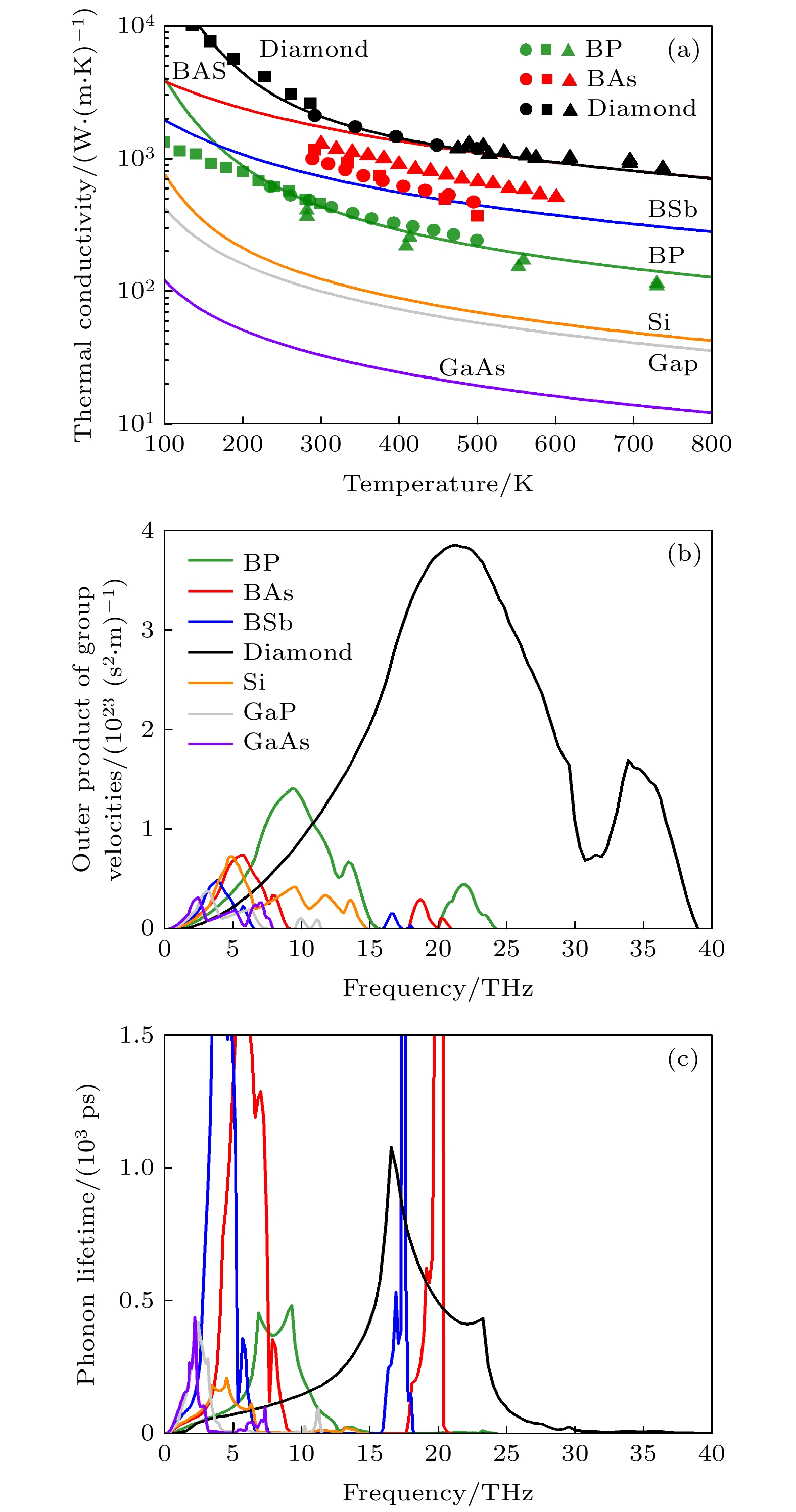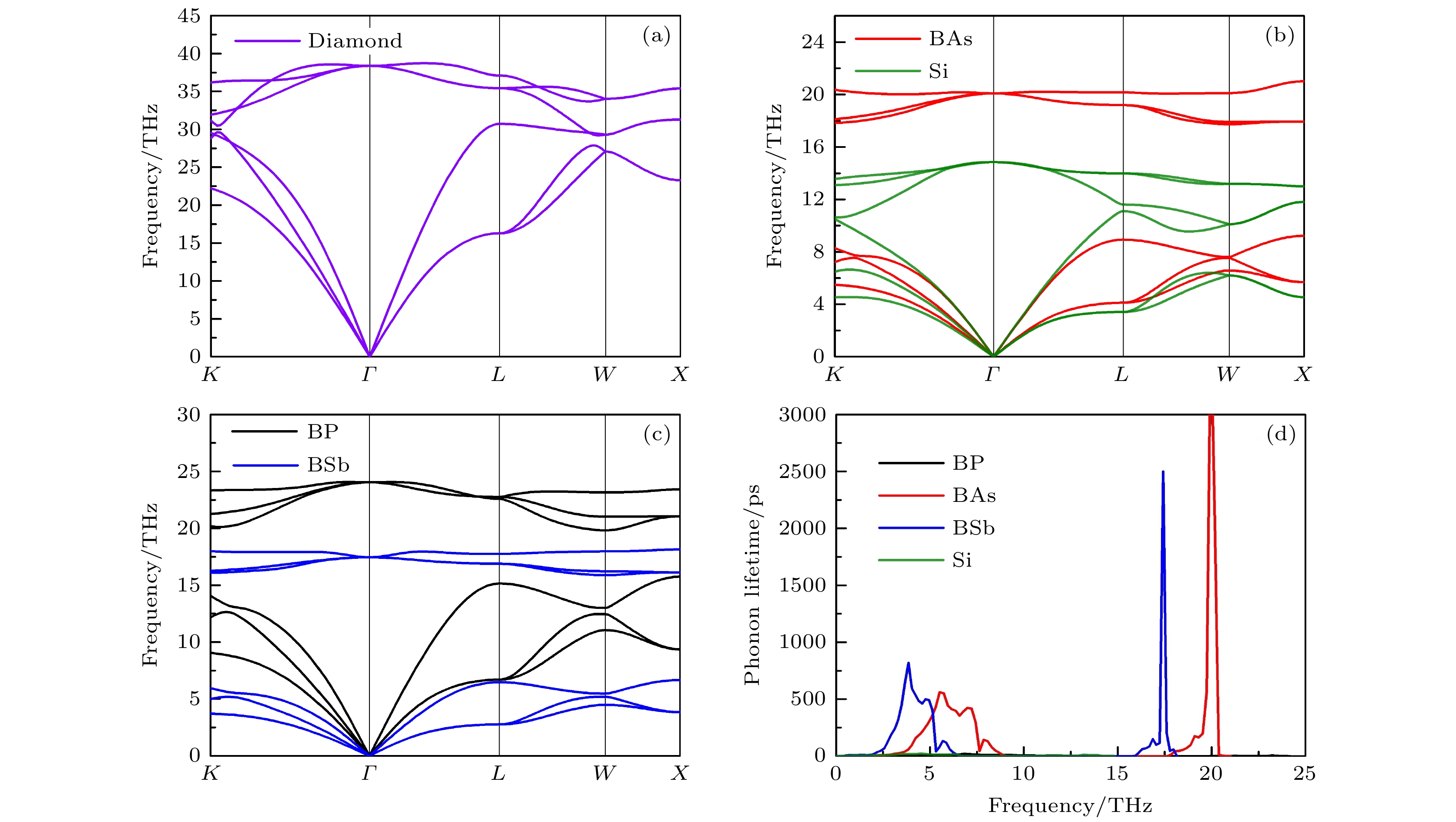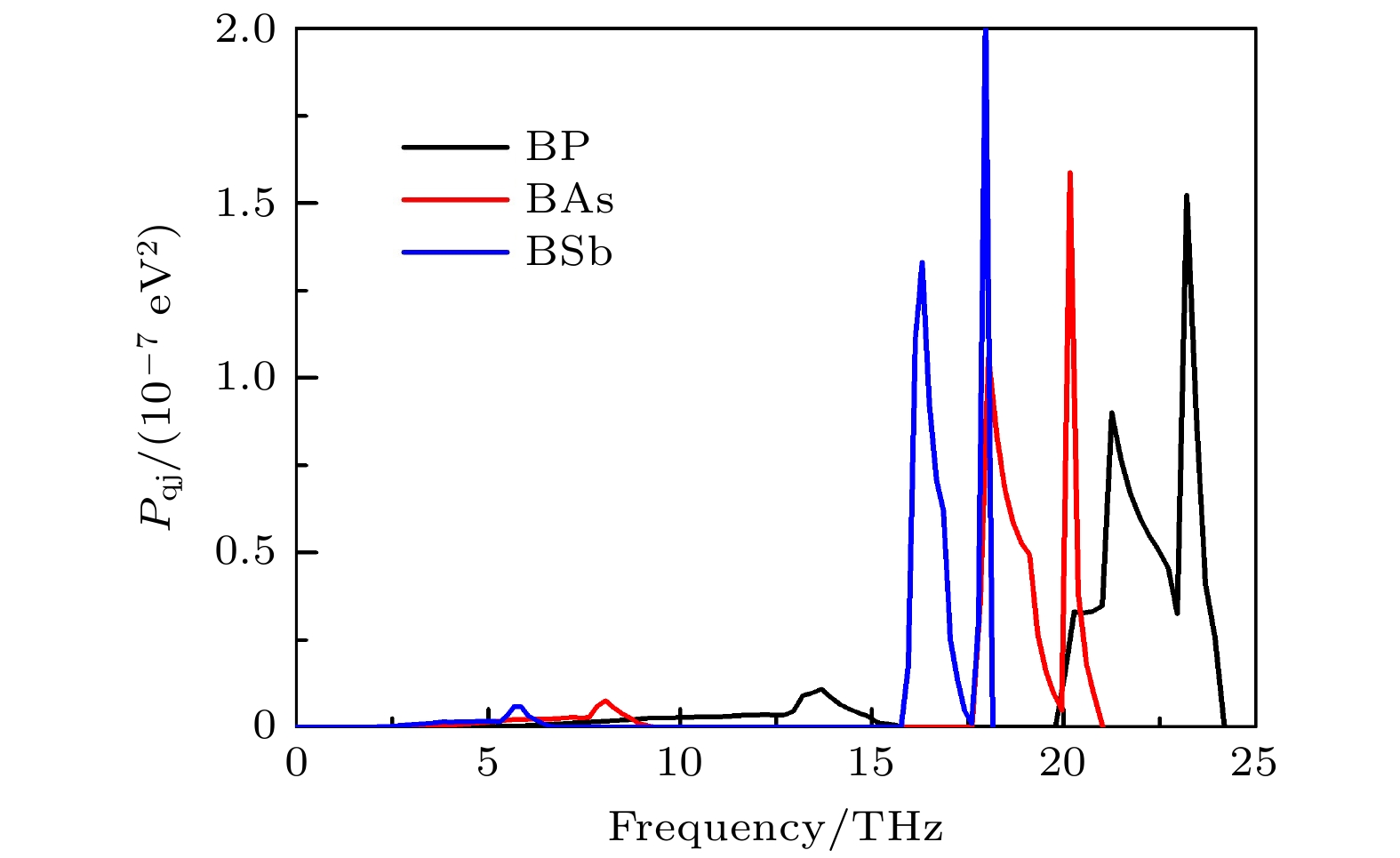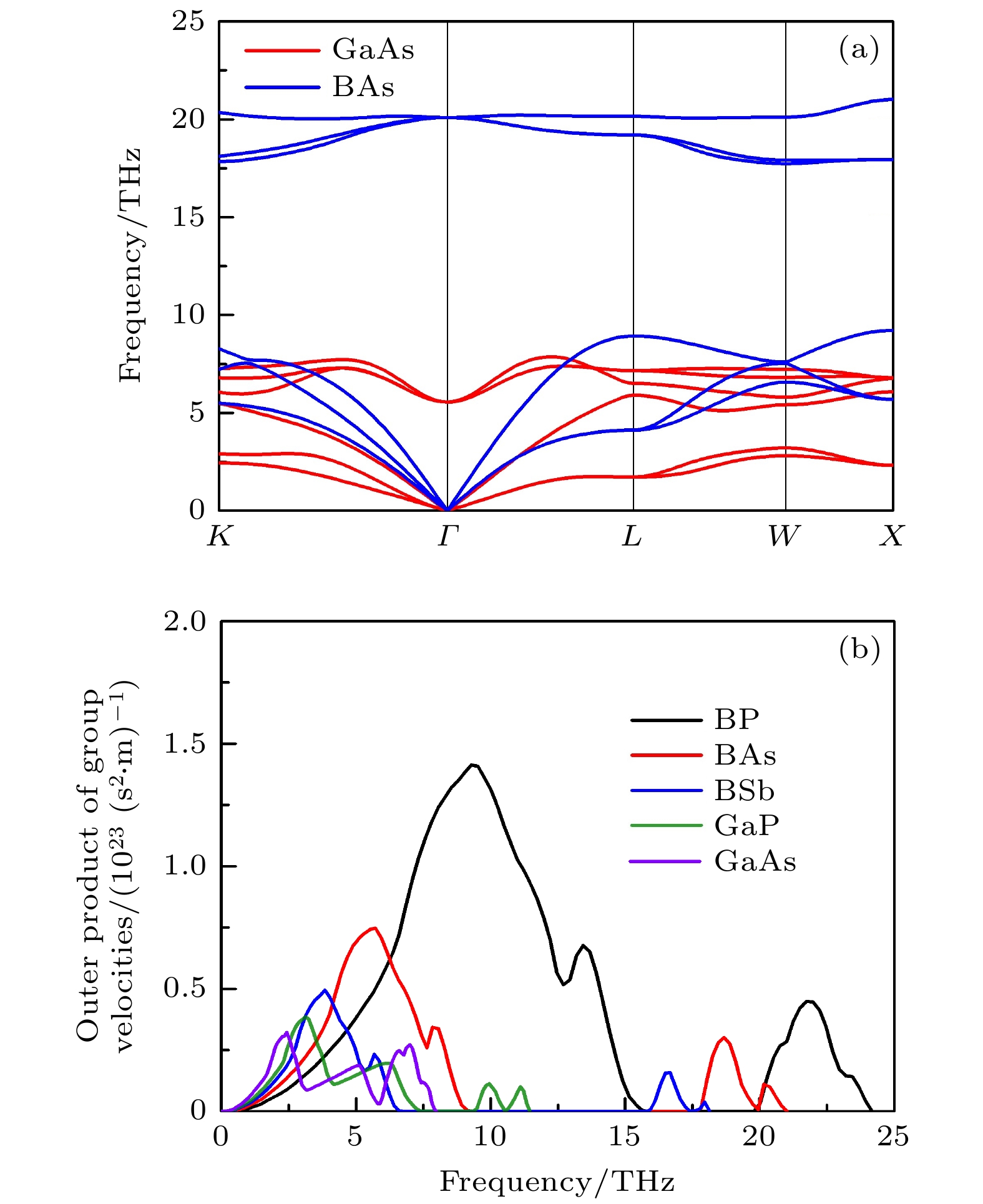-
Over the past half-century, according to Moore’s law, the sizes of transistors continue shrinking, and the integrated circuits have approached to their physical limits, which puts forward higher requirements for the thermal dissipation capacity of material. Revealing the physical mechanisms of heat conduction in semiconductors is important for thermal managements of devices. Experimentally, it was found that boron arsenide has a very high thermal conductivity compared with diamond, and boron arsenide has lattice constant close to silicon’s lattice constant, which can be heterogeneously integrated into silicon to solve the thermal management problem. However, group III-V boron compounds show abnormal thermal conductivities: the thermal conductivity of boron arsenide is significantly higher than that of boron phosphide and boron antimonide. Here, we use the first-principles calculation and the Boltzmann transport equation to study the thermal conductivity properties of the group III-V boron compounds. Comparison between the IV and III-V semiconductors shows that the high thermal conductivity of boron arsenide is due mainly to the existence of a large frequency gap between the acoustic and the optical branches. The energy sum of two acoustic phonons is less than energy of one optical phonon, which cannot meet the energy conservation requirements of three-phonon scattering, and then seriously restrict the probability of scattering of three phonons. The high thermal conductivity of diamond is due mainly to its great acoustic phonon group velocity. Although the boron phosphide also has a relatively large acoustic phonon group velocity, the frequency gap is relatively small, which cannot effectively suppress the three-phonon scattering, so the thermal conductivity of boron phosphide is less than that of boron arsenide. Although the frequency gap of boron antimonide is similar to that of boron arsenide, the thermal conductivity of boron antimonide is lower than that of boron arsenide due to its smaller acoustic phonon group velocity and larger coupling matrix element. The research provides a new insight into the design of semiconductor materials with high thermal conductivities.
-
Keywords:
- group III-V semiconductors /
- boron arsenide /
- thermal conductivity /
- anharmonicity
[1] 王拓, 陈弘毅, 仇鹏飞, 史迅, 陈立东 2019 物理学报 68 090201
 Google Scholar
Google Scholar
Wang T, Chen H Y, Qiu P F, Shi X, Chen L D 2019 Acta Phys. Sin. 68 090201
 Google Scholar
Google Scholar
[2] 张雪冰, 刘乃漳, 姚若河 2020 物理学报 69 157303
 Google Scholar
Google Scholar
Zhang X B, Liu N Z, Yao R H 2020 Acta Phys. Sin. 69 157303
 Google Scholar
Google Scholar
[3] Slack G A 1973 J. Phys. Chem. Solids 34 321
 Google Scholar
Google Scholar
[4] Wei L, Kuo P K, Thomas R L, Anthony T R, Banholzer W F 1993 Phys. Rev. Lett. 70 3764
 Google Scholar
Google Scholar
[5] Lindsay L, Broido D A 2008 J. Phys.: Condens. Matter 20 165209
 Google Scholar
Google Scholar
[6] Holland M G 1964 Phys. Rev. 134 A471
 Google Scholar
Google Scholar
[7] Feng T, Lindsay L, Ruan X 2017 Phys. Rev. B 96 161201
 Google Scholar
Google Scholar
[8] Lindsay L, Broido D A, Mingo N 2009 Phys. Rev. B 80 125407
 Google Scholar
Google Scholar
[9] Yang X, Feng T, Li J, Ruan X 2019 Phys. Rev. B 100 245203
 Google Scholar
Google Scholar
[10] Shiga T, Shiomi J, Ma J, Delaire O, Radzynski T, Lusakowski A, Esfarjani K, Chen G 2012 Phys. Rev. B 85 155203
 Google Scholar
Google Scholar
[11] Chaput L, Togo A, Tanaka I, Hug G 2011 Phys. Rev. B 84 094302
 Google Scholar
Google Scholar
[12] Dames C 2018 Science 361 549
 Google Scholar
Google Scholar
[13] Kang J S, Li M, Wu H, Nguyen H, Hu Y 2018 Science 361 575
 Google Scholar
Google Scholar
[14] Li S, Zheng Q, Lv Y, Liu X, Wang X, Huang P Y, Cahill D G, Lv B 2018 Science 361 579
 Google Scholar
Google Scholar
[15] Tian F, Song B, Chen X, Ravichandran N K, Lv Y, Chen K, Sullivan S, Kim J, Zhou Y, Liu T H, Goni M, Ding Z, Sun J, Gamage G A G U, Sun H, Ziyaee H, Huyan S, Deng L, Zhou J, Schmidt A J, Chen S, Chu C W, Huang P Y, Broido D, Shi L, Chen G, Ren Z 2018 Science 361 582
 Google Scholar
Google Scholar
[16] Lindsay L, Broido D A, Reinecke T L 2013 Phys. Rev. Lett. 111 025901
 Google Scholar
Google Scholar
[17] Cao R, Deng H X, Luo J W, Wei S H 2019 J. Semicond. 40 042102
 Google Scholar
Google Scholar
[18] Togo A, Chaput L, Tanaka I 2015 Phys. Rev. B 91 094306
 Google Scholar
Google Scholar
[19] Maradudin A A, Fein A E 1962 Phys. Rev. 128 2589
 Google Scholar
Google Scholar
[20] Lax M, Hu P, Narayanamurti V 1981 Phys. Rev. B 23 3095
 Google Scholar
Google Scholar
[21] Ward A, Broido D A, Stewart D A, Deinzer G 2009 Phys. Rev. B 80 125203
 Google Scholar
Google Scholar
[22] Broido D A, Malorny M, Birner G, Mingo N, Stewart D A 2007 Appl. Phys. Lett. 91 231922
 Google Scholar
Google Scholar
[23] Tian Z, Garg J, Esfarjani K, Shiga T, Shiomi J, Chen G 2012 Phys. Rev. B 85 184303
 Google Scholar
Google Scholar
[24] Blochl P E 1994 Phys. Rev. B 50 17953
 Google Scholar
Google Scholar
[25] Abeles B 1963 Phys. Rev. 131 1906
 Google Scholar
Google Scholar
[26] Mizokami K, Togo A, Tanaka I 2018 Phys. Rev. B 97 224306
 Google Scholar
Google Scholar
[27] Chaput L 2013 Phys. Rev. Lett. 110 265506
 Google Scholar
Google Scholar
[28] Wang L 2019 J. Semicond. 40 091101
 Google Scholar
Google Scholar
[29] Zheng Q, Li S, Li C, Lv Y, Liu X, Huang P Y, Broido D A, Lv B, Cahill D G 2018 Adv. Funct. Mater. 28 1805116
 Google Scholar
Google Scholar
[30] Kang J S, Wu H, Hu Y 2017 Nano Lett. 17 7507
 Google Scholar
Google Scholar
[31] Kumashiro Y, Mitsuhashi T, Okaya S, Muta F, Koshiro T, Takahashi Y, Mirabayashi M 1989 J. Appl. Phys. 65 2147
 Google Scholar
Google Scholar
[32] Berman R, Hudson P R W, Martinez M 1975 J. Phys. C: Solid State Phys. 8 430
 Google Scholar
Google Scholar
[33] Olson J R, Pohl R O, Vandersande J W, Zoltan A, Anthony T R, Banholzer W F 1993 Phys. Rev. B 47 14850
 Google Scholar
Google Scholar
[34] 基泰尔C著 (项金钟, 吴兴惠译) 2005 固体物理导论 (北京: 化学工业出版社) 第71−74页
Kittel C (translated by Xiang J Z, Wu X H) 2005 Introduction to Solid State Physics (Beijing: Chemical Industry Press) pp71−74 (in Chinese)
[35] Pavone P, Karch K, Schutt O, Strauch D, Windl W, Giannozzi P, Baroni S 1993 Phys. Rev. B 48 3156
 Google Scholar
Google Scholar
[36] Fukumoto A 1990 Phys. Rev. B 42 7462
 Google Scholar
Google Scholar
[37] Harrison W A 2004 Elementary Electronic Structure (Revised Edition) (Singapore: World Scientific Publishing Co Pte Ltd) pp126−128
-
图 1 (a)半导体材料热导率的第一性原理计算(实线), 不同颜色对应不同材料热导率值. 另外离散点来源于已有文献中实验测量的热导率数据, 其中墨绿色的圆圈[29]、正方形[30]和三角形[31]对应BP; 红色的圆圈[14]、正方形[15]和三角形[13]对应BAs; 黑色的圆圈[15]、正方形[32]和三角形[33]对应金刚石材料. (b) 各种不同半导体材料在单位体积下声子群速度的外积(
${v_{\lambda} } \otimes {v_{\lambda} }{{/}}{V_0}$ )随晶格振动频率的变化. (c)温度为100 K时各种半导体材料声子弛豫时间随晶格振动频率的变化Figure 1. (a) First-principles calculation of thermal conductivity of semiconductor materials (solid line), different colors correspond to different materials. In addition, the discrete points are derived from the thermal conductivity data measured experimentally in existing literature. The olive circles[29], squares[30] and triangles[31] correspond to BP. Red circles[14], squares[15] and triangles[13] correspond to BAs. Black circles[15], squares[32] and triangles[33] correspond to diamond. (b) Outer product of phonon group velocities per unit volume of various semiconductor materials as a function of frequency(
${v_{\lambda} } \otimes {v_{\lambda} }{{/}}{V_0}$ ). (c) Phonon relaxation time of various semiconductor materials at 100 K as a function of frequency.图 2 (a)金刚石 (紫色)的晶格振动谱; (b) BAs (红色)和Si (墨绿色)的晶格振动谱; (c) BP (黑色)和BSb (蓝色)的晶格振动谱; (d) BP, BAs, BSb和Si的声子寿命或弛豫时间
Figure 2. (a) Lattice vibration spectrum of diamond (violet); (b) lattice vibration spectrum of boron arsenide (red) and silicon (olive); (c) lattice vibration spectra of boron phosphide (black) and boron antimonide (blue); (d) phonon lifetime of boron phosphide, boron arsenide, boron antimony and silicon.
表 1 BP, BAs, BSb以及Si的横向光学模式最大振动频率(
${\omega _{{\rm{TO}}}}$ )、横向声学模式最大振动频率(${\omega _{{\rm{TA}}}}$ )、频率间隙($\varDelta = {\omega _{{\rm{TO}}}} - {\omega _{{\rm{TA}}}}$ )、组成化合物的元素的原子质量(m, M)、CTable 1. Maximum vibration frequency of transverse optical mode, maximum vibration frequency of transverse acoustic mode, frequency gap, atomic mass of elements of compound and elastic force constant of boron phosphide, boron arsenide, boron antimonide and silicon.
物理量 BAs BP BSb Si ${\omega _{{\rm{TO}}}}$/THz 19.19 22.60 16.90 14.84 ${\omega _{{\rm{TA}}}}$/THz 8.93 15.15 6.48 11.09 Δ/THz 10.26 7.45 10.42 3.75 m/amu 10.8 10.8 10.8 28.09 M/amu 74.95 30.97 121.8 28.09 $\left( {\sqrt {\tfrac{ {\rm{1} } }{m} } - \sqrt {\tfrac{ {\rm{1} } }{M} } } \right)$/amu–0.5 0.188 0.124 0.213 0 力常数C/(eV·Å–2) 15.2911 19.0982 12.3004 12.3523 $\sqrt C $/(eV0.5·Å–1) 3.910 4.370 3.507 3.514 表 2 各族元素原子p轨道能量(单位为Ry), 其中列出了具体的元素名称
Table 2. Atomic p orbital energies of each group of elements (in Ry), and the specific names of the elements are listed.
原子轨
道能量IIA或IIB族 IIIA族 IVA族 VA族 VIA族 2p Be B C N O –0.1608 –0.2795 –0.4044 –0.5382 –0.6819 3p Mg Al Si P S –0.1068 –0.2103 –0.3125 –0.4174 –0.5288 4p Zn Ga Ge As Se –0.0964 –0.2073 –0.3040 –0.3985 –0.4956 5p Cd In Sn Sb Te –0.1034 –0.2044 –0.2907 –0.3734 –0.4557 6p Hg Tl Pb Bi Po –0.0928 –0.1957 –0.2788 –0.3569 –0.4335 -
[1] 王拓, 陈弘毅, 仇鹏飞, 史迅, 陈立东 2019 物理学报 68 090201
 Google Scholar
Google Scholar
Wang T, Chen H Y, Qiu P F, Shi X, Chen L D 2019 Acta Phys. Sin. 68 090201
 Google Scholar
Google Scholar
[2] 张雪冰, 刘乃漳, 姚若河 2020 物理学报 69 157303
 Google Scholar
Google Scholar
Zhang X B, Liu N Z, Yao R H 2020 Acta Phys. Sin. 69 157303
 Google Scholar
Google Scholar
[3] Slack G A 1973 J. Phys. Chem. Solids 34 321
 Google Scholar
Google Scholar
[4] Wei L, Kuo P K, Thomas R L, Anthony T R, Banholzer W F 1993 Phys. Rev. Lett. 70 3764
 Google Scholar
Google Scholar
[5] Lindsay L, Broido D A 2008 J. Phys.: Condens. Matter 20 165209
 Google Scholar
Google Scholar
[6] Holland M G 1964 Phys. Rev. 134 A471
 Google Scholar
Google Scholar
[7] Feng T, Lindsay L, Ruan X 2017 Phys. Rev. B 96 161201
 Google Scholar
Google Scholar
[8] Lindsay L, Broido D A, Mingo N 2009 Phys. Rev. B 80 125407
 Google Scholar
Google Scholar
[9] Yang X, Feng T, Li J, Ruan X 2019 Phys. Rev. B 100 245203
 Google Scholar
Google Scholar
[10] Shiga T, Shiomi J, Ma J, Delaire O, Radzynski T, Lusakowski A, Esfarjani K, Chen G 2012 Phys. Rev. B 85 155203
 Google Scholar
Google Scholar
[11] Chaput L, Togo A, Tanaka I, Hug G 2011 Phys. Rev. B 84 094302
 Google Scholar
Google Scholar
[12] Dames C 2018 Science 361 549
 Google Scholar
Google Scholar
[13] Kang J S, Li M, Wu H, Nguyen H, Hu Y 2018 Science 361 575
 Google Scholar
Google Scholar
[14] Li S, Zheng Q, Lv Y, Liu X, Wang X, Huang P Y, Cahill D G, Lv B 2018 Science 361 579
 Google Scholar
Google Scholar
[15] Tian F, Song B, Chen X, Ravichandran N K, Lv Y, Chen K, Sullivan S, Kim J, Zhou Y, Liu T H, Goni M, Ding Z, Sun J, Gamage G A G U, Sun H, Ziyaee H, Huyan S, Deng L, Zhou J, Schmidt A J, Chen S, Chu C W, Huang P Y, Broido D, Shi L, Chen G, Ren Z 2018 Science 361 582
 Google Scholar
Google Scholar
[16] Lindsay L, Broido D A, Reinecke T L 2013 Phys. Rev. Lett. 111 025901
 Google Scholar
Google Scholar
[17] Cao R, Deng H X, Luo J W, Wei S H 2019 J. Semicond. 40 042102
 Google Scholar
Google Scholar
[18] Togo A, Chaput L, Tanaka I 2015 Phys. Rev. B 91 094306
 Google Scholar
Google Scholar
[19] Maradudin A A, Fein A E 1962 Phys. Rev. 128 2589
 Google Scholar
Google Scholar
[20] Lax M, Hu P, Narayanamurti V 1981 Phys. Rev. B 23 3095
 Google Scholar
Google Scholar
[21] Ward A, Broido D A, Stewart D A, Deinzer G 2009 Phys. Rev. B 80 125203
 Google Scholar
Google Scholar
[22] Broido D A, Malorny M, Birner G, Mingo N, Stewart D A 2007 Appl. Phys. Lett. 91 231922
 Google Scholar
Google Scholar
[23] Tian Z, Garg J, Esfarjani K, Shiga T, Shiomi J, Chen G 2012 Phys. Rev. B 85 184303
 Google Scholar
Google Scholar
[24] Blochl P E 1994 Phys. Rev. B 50 17953
 Google Scholar
Google Scholar
[25] Abeles B 1963 Phys. Rev. 131 1906
 Google Scholar
Google Scholar
[26] Mizokami K, Togo A, Tanaka I 2018 Phys. Rev. B 97 224306
 Google Scholar
Google Scholar
[27] Chaput L 2013 Phys. Rev. Lett. 110 265506
 Google Scholar
Google Scholar
[28] Wang L 2019 J. Semicond. 40 091101
 Google Scholar
Google Scholar
[29] Zheng Q, Li S, Li C, Lv Y, Liu X, Huang P Y, Broido D A, Lv B, Cahill D G 2018 Adv. Funct. Mater. 28 1805116
 Google Scholar
Google Scholar
[30] Kang J S, Wu H, Hu Y 2017 Nano Lett. 17 7507
 Google Scholar
Google Scholar
[31] Kumashiro Y, Mitsuhashi T, Okaya S, Muta F, Koshiro T, Takahashi Y, Mirabayashi M 1989 J. Appl. Phys. 65 2147
 Google Scholar
Google Scholar
[32] Berman R, Hudson P R W, Martinez M 1975 J. Phys. C: Solid State Phys. 8 430
 Google Scholar
Google Scholar
[33] Olson J R, Pohl R O, Vandersande J W, Zoltan A, Anthony T R, Banholzer W F 1993 Phys. Rev. B 47 14850
 Google Scholar
Google Scholar
[34] 基泰尔C著 (项金钟, 吴兴惠译) 2005 固体物理导论 (北京: 化学工业出版社) 第71−74页
Kittel C (translated by Xiang J Z, Wu X H) 2005 Introduction to Solid State Physics (Beijing: Chemical Industry Press) pp71−74 (in Chinese)
[35] Pavone P, Karch K, Schutt O, Strauch D, Windl W, Giannozzi P, Baroni S 1993 Phys. Rev. B 48 3156
 Google Scholar
Google Scholar
[36] Fukumoto A 1990 Phys. Rev. B 42 7462
 Google Scholar
Google Scholar
[37] Harrison W A 2004 Elementary Electronic Structure (Revised Edition) (Singapore: World Scientific Publishing Co Pte Ltd) pp126−128
Catalog
Metrics
- Abstract views: 11237
- PDF Downloads: 300
- Cited By: 0

















 DownLoad:
DownLoad:






